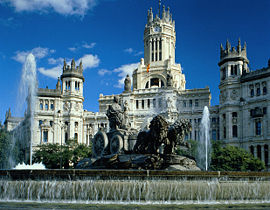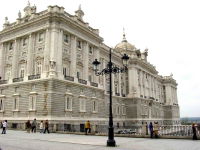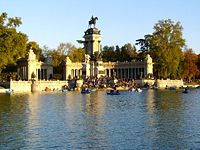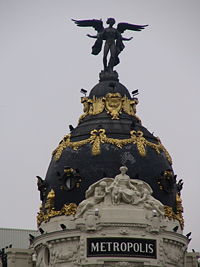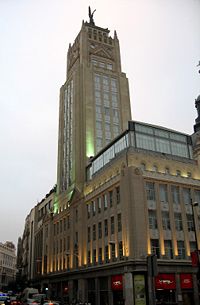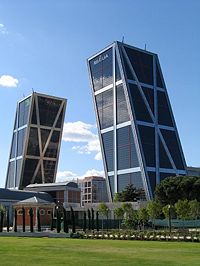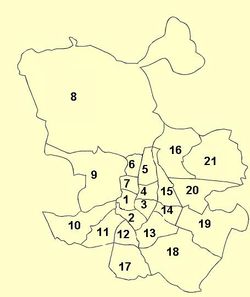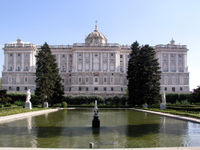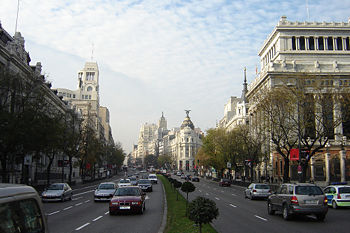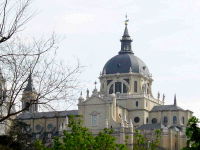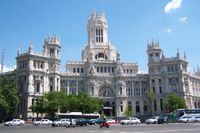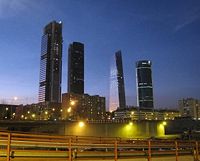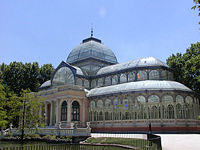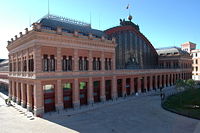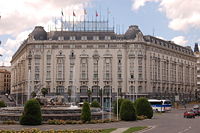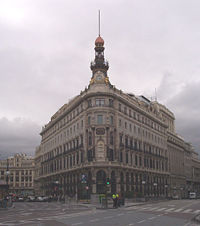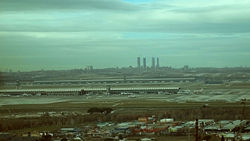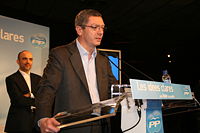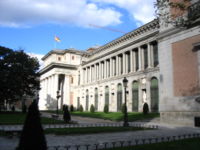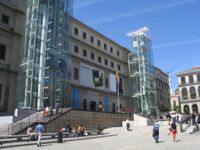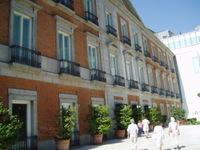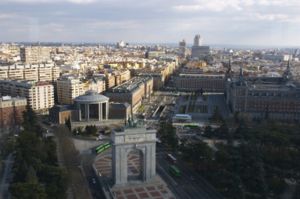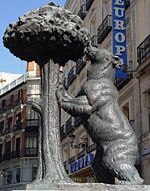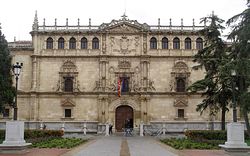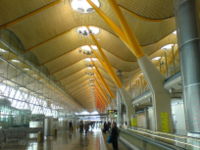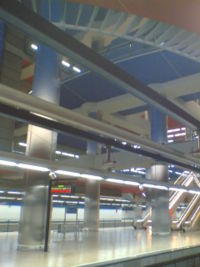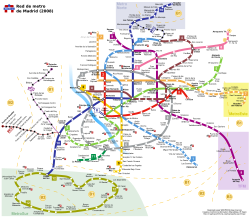Madrid
2008/9 Schools Wikipedia Selection. Related subjects: Europe; European Cities
| Madrid | |||
| Comunicaciones palace in Cibeles | |||
|
|||
| Motto: De Madrid al Cielo (From Madrid to Heaven) |
|||
| Coordinates: | |||
|---|---|---|---|
| Founded | 8th century | ||
| Government | |||
| - Mayor | Alberto Ruiz-Gallardón ( PP) | ||
| Area | |||
| - Land | 607 km² (234.4 sq mi) | ||
| Elevation | 667 m (2,188 ft) | ||
| Population (2005) | |||
| - City | 3,228,359 | ||
| - Density | 5,198/km² (13,462.8/sq mi) | ||
| - Metro | 5,561,748 | ||
| population-ranking: 1st | |||
| Time zone | CET ( UTC+1) | ||
| - Summer ( DST) | CEST ( UTC+2) | ||
| Postal code | 28001-28080 | ||
| Area code(s) | 34 (Spain) + 91 (Madrid) | ||
| Website: www.munimadrid.es (Spanish) | |||
Madrid (pronounced [ma'ð̞ɾið̞] in Spanish, and [məˈdɹɪd] in English) is the capital and largest city of Spain. It is the third largest city of the European Union, after London and Berlin.
The city is located on the river Manzanares both in the centre of the country and Community of Madrid (which comprises the city of Madrid, its subsequent conurbation and extended suburbs and villages); this community is bordered by the autonomous communities of Castile and León and Castile-La Mancha. As the capital city of Spain, seat of government, and residence of the Spanish monarch, Madrid is also the political centre of Spain. The current mayor is Alberto Ruiz-Gallardón from the centre-right People's Party. He has been in office since 2003, when he left the Presidency of the Autonomous Community of Madrid and stood as the candidate to replace outgoing mayor José María Álvarez del Manzano, also from the PP. In the last local elections of 2007, Ruiz-Gallardón increased the PP majority in the City Council to 34 seats out of 57, taking 55.5% of the popular vote and winning in all but two districts.
As the capital, Madrid is a city of cultural and political importance. It is also the third European economic centre, and its international airport at Barajas is the largest in Spain. Due to its economic output, standard of living, and market size, Madrid is considered the major financial centre of the Iberian Peninsula; it hosts the head offices of the vast majority of the major Spanish companies, as well as the headquarters of three of the world's 100 largest companies ( Telefónica, Repsol-YPF, Endesa).
While Madrid possesses a modern infrastructure, it has preserved the look and feel of many of its historic neighborhoods and streets. Its landmarks include the huge Royal Palace of Madrid; the Teatro Real (Royal theatre) with its restored 1850 Opera House; the Buen Retiro park, founded in 1631; the imposing 19th-century National Library building (founded in 1712) containing some of Spain's historical archives; an archaeological museum of international reputation; and three superb art museums: Prado Museum, which hosts one of the finest art collections in the world, the Museo Nacional Centro de Arte Reina Sofía, a museum of modern art, and the Thyssen-Bornemisza Museum, housed in the renovated Villahermosa Palace.
The population of the city is roughly 3.2 million (December 2005), while the estimated urban area population is 5.1 million. The entire population of the Madrid metropolitan area (urban area and suburbs) is calculated to be 5.84 million. The city spans a total of 607 km² (234 sq mi).
Names of the city and origin of the current name
There are several theories regarding the origin of the name "Madrid". According to legend Madrid was founded by Ocno Bianor (son of King Tyrrhenius of Tuscany and Mantua) and was named "Metragirta" or "Mantua Carpetana". Others contend that the original name of the city was "Ursaria" ("land of bears" in Latin), due to the high number of these animals that were found in the adjacent forests, which, together with the strawberry tree ("madroño" in Spanish), have been the emblem of the city from the Middle Ages.
Nevertheless,it is now commonly believed that the origin of the current name of the city comes from the 2nd century B.C., the Roman Empire established a settlement on the banks of the Manzanares river. The name of this first village was "Matrice" (a reference to the river that crossed the settlement). Following the invasions of the Germanic Sueves, Vandals and Alans during the fifth century A.D., the Roman Empire could not defend its territories on the Iberian Peninsula, and were therefore overrun by the Visigoths. The barbarian tribes subsequently took control of "Matrice". In the 7th century the Islamic conquest of the Iberian Peninsula saw the name changed to "Mayrit", from the Arabic term "Mayra" (referencing water as a "trees" or "giver of life") and the Ibero-Roman suffix "it" that means "place". The modern "Madrid" evolved from the Mozarabic "Matrit", which is still in the Madrilenian gentilic.
History
Middle Ages
Although the site of modern-day Madrid has been occupied since pre-historic times, in the Roman era this territory belonged to the diocese of Complutum (present-day Alcalá de Henares). There are archeological remains of a small village during the visigoth epoch, whose name might have been adopted later by arabs. The origins of the modern city come from the 9th century, when Muhammad I ordered the construction of a small palace in the same place that is today occupied by the Palacio Real. Around this palace a small citadel, al-Mudaina, was built. Near that palace was the Manzanares, which the Muslims called al-Majrīṭ (Arabic: المجريط, "source of water"). From this came the naming of the site as Majerit, which later evolved into the modern-day spelling of Madrid. The citadel was conquered in 1085 by christian king Alfonso VI of Castile in his advance towards Toledo. He reconsecrated the mosque as the church of the Virgin of Almudena (almudin, the garrison's granary). In 1329, the Cortes Generales first assembled in the city to advise Alfonso XI of Castile. Sephardi Jews and Moors continued to live in the city until they were expelled at the end of the 15th century. After troubles and a large fire, Henry III of Castile (1379–1406) rebuilt the city and established himself safely fortified outside its walls in El Pardo. The grand entry of Ferdinand and Isabella to Madrid heralded the end of strife between Castile and Aragon.
Renaissance
The Kingdom of Castile, with its capital at Toledo, and the Crown of Aragon, with its capital at Zaragoza, were welded into modern Spain by the Catholic Monarchs (Queen Isabella of Castile and King Ferdinand II of Aragon).
Though their grandson Charles I of Spain (also known as Charles V, Holy Roman Emperor) favoured Seville, it was Charles' son, Philip II (1527–1598) who moved the court to Madrid in 1561. Although he made no official declaration, the seat of the court was the de facto capital. Seville continued to control commerce with Spain's colonies, but Madrid controlled Seville.
Aside from a brief period, 1601-1606, when Felipe III installed his court in Valladolid, Madrid's fortunes have closely mirrored those of Spain. During the Siglo de Oro (Golden Century), in the 16th/17th century, Madrid bore little resemblance to other European capitals, as the population of the city was economically dependent on the business of the court itself, and there was no other significant activity.
From 19th century to present day
In the late 1800s, Isabel II could not suppress the political tension that would lead to yet another revolt, the First Spanish Republic. This was later followed by the return of the monarchy to Madrid, then the creation of the Second Spanish Republic, preceding the Spanish Civil War.
Madrid was one of the most heavily affected cities of Spain by the Civil War (1936–1939). The city was a stronghold of the Republicans from July 1936. Its western suburbs were the scene of an all-out battle in November 1936 and it was during the Civil War that Madrid became the first city to be bombed by airplanes specifically targeting civilians in the history of warfare. (See Siege of Madrid (1936-39)).
During the dictatorship of Francisco Franco, especially during the 1960s, the south of Madrid became very industrialized, and there were massive migrations from rural areas of Spain into the city. Madrid's south-eastern periphery became an extensive working class settlement, which was the base for an active cultural and political reform.
After the death of Franco, emerging democratic parties (including those of left-wing and republican ideology) accepted Franco's wishes of being succeeded by Juan Carlos I - in order to secure stability and democracy. This led Spain to its current position as a constitutional monarchy, with Madrid as capital.
Benefiting from increasing prosperity in the 1980s and 1990s, the capital city of Spain has consolidated its position as the first economic, cultural, industrial, educational, and technological centre on the Iberian peninsula.
Today Madrid shows itself as an open city proud of its economical wealth and international respect and open to a new era of art and culture leadership in the Iberian peninsula.
Geography
Topography and climate
| Climate chart for Madrid | |||||||||||
|---|---|---|---|---|---|---|---|---|---|---|---|
| J | F | M | A | M | J | J | A | S | O | N | D |
|
37
10
3
|
35
12
4
|
26
16
6
|
47
18
7
|
48
21
11
|
25
27
15
|
10
33
18
|
10
32
18
|
28
26
15
|
49
19
10
|
56
13
6
|
56
10
4
|
| temperatures in °C precipitation totals in mm |
|||||||||||
|
Imperial conversion
|
|||||||||||
The region of Madrid has a temperate Continental Mediterranean climate (Koppen Csa) with cool winters and frequent temperatures below 0 °C (32 °F). There are about 2 to 3 snowfalls each year. Summer tends to be hot with temperatures that consistently surpass 30 °C (86 °F) in July and that can often reach 40 °C (104 °F). Due to Madrid's high altitude and dry climate, nightly temperatures tend to be cooler, leading to a lower average in the summer months. Precipitation levels are low, but precipitation can be observed all throughout the year. Summer and winter are the driest seasons, with most rainfall occurring in the autumn and spring.
Water supply
Madrid derives almost 50 percent of its water supply from dams and reservoirs built on the Lozoya River, such as the El Atazar Dam.
Districts
Madrid is administratively divided into 21 districts, which are further subdivided into 128 wards (barrios):
- Centro: Palacio, Embajadores, Cortes, Justicia, Universidad, Sol.
- Arganzuela: Paseo Imperial, Acacias, Chopera, Legazpi, Delicias, Palos de la Frontera, Atocha.
- Retiro: Pacífico, Adelfas, Estrella, Ibiza, Jerónimos, Niño Jesús.
- Salamanca: Recoletos, Goya, Fuente del Berro, Guindalera, Lista, Castellana.
- Chamartín: El Viso, Prosperidad, Ciudad Jardín, Hispanoamérica, Nueva España, Pza. Castilla.
- Tetuán: Bellas Vistas, Cuatro Caminos, Castillejos, Almenara, Valdeacederas, Berruguete.
- Chamberi: Gaztambide, Arapiles, Trafalgar, Almagro, Vallehermoso, Ríos Rosas.
- Fuencarral-El Pardo: El Pardo, Fuentelarreina, Peñagrande, Barrio del Pilar, La Paz, Valverde, Mirasierra, El Goloso.
- Moncloa-Aravaca: Casa de Campo, Argüelles, Ciudad Universitaria, Valdezarza, Valdemarín, El Plantío, Aravaca.
- Latina: Los Cármenes, Puerta del Ángel, Lucero, Aluche, Las Águilas, Campamento, Cuatro Vientos.
- Carabanchel: Comillas, Opañel, San Isidro, Vista Alegre, Puerta Bonita, Buenavista, Abrantes.
- Usera: Orcasitas, Orcasur, San Fermín, Almendrales, Moscardó, Zofio, Pradolongo.
- Puente de Vallecas: Entrevías, San Diego, Palomeras Bajas, Palomeras Sureste, Portazgo, Numancia.
- Moratalaz: Pavones, Horcajo, Marroquina, Media Legua, Fontarrón, Vinateros.
- Ciudad Lineal: Ventas, Pueblo Nuevo, Quintana, La Concepción, San Pascual, San Juan Bautista, Colina, Atalaya, Costillares.
- Hortaleza: Palomas, Valdefuentes, Canillas, Pinar del Rey, Apóstol Santiago, Piovera.
- Villaverde: San Andrés, San Cristóbal, Butarque, Los Rosales, Los Ángeles (Villaverde).
- Villa de Vallecas: Casco Histórico de Vallecas, Santa Eugenia.
- Vicálvaro: Casco Histórico de Vicálvaro, Ambroz.
- San Blas: Simancas, Hellín, Amposta, Arcos, Rosas, Rejas, Canillejas, Salvador.
- Barajas: Alameda de Osuna, Aeropuerto, Casco Histórico de Barajas, Timón, Corralejos.
Architecture
Although the site of Madrid has been occupied since prehistoric times, the first historical data we have from the city is from the middle of the ninth Century, when Mohamed I ordered the construction of a small palace (site occupied now by the Palacio Real). Around this palace there was built a small citadel (al-Mudaina). The palace was built overlooking the River Manzanares, which the muslims called Mayrit meaning source of water (which in turn became Magerit, and then eventually Madrid). The citadel was conquered in 1085 by Alfonso VI in his advance towards Toledo. He reconsecrated the mosque as the church of the Virgin of Almudena (almudin, the garrison's granary), now the Catedral de la Almudena. In 1329 the Cortes first assembled in Madrid to advise Fernando IV. Jews and Moors continued to live in the city in their quarter, still known today as the "Moreria", until they were expelled. The Royal Palace of Madrid and the buildings and monuments of the Paseo del Prado (Salón del Prado and Alcalá Gate) deserve special mention. They were constructed in a sober Baroque international style, often mistaken for neoclassical, by the Bourbon kings Philip V and Charles III. The royal palaces of La Granja de San Ildefonso (in Segovia province) and Aranjuez (south of Madrid), are good examples of baroque integration of architecture and gardening. They have a noticeable French influence (La Granja is known as the "Spanish Versailles"), but with local spatial conceptions which in some ways display the heritage of the Moorish occupation.
Plans for the construction of a new cathedral for Madrid dedicated to the Virgin of Almudena began in the 16th century, but the slow construction did not begin until 1879. Francisco de Cubas, the Marquis of Cubas, was the architect who designed and directed the construction in a Gothic revival style. Construction ceased completely during the Spanish Civil War. The project was abandoned until 1950, when Fernando Chueca Goitia adapted the plans of de Cubas to a neoclassical style exterior to match the grey and white façade of the Palacio Real, which stands directly opposite. and was not completed until 1993, when the cathedral was consecrated by Pope John Paul II.
The financial district in downtown Madrid between the streets Raimundo Fernández Villaverde, Orense, General Perón and Paseo de la Castellana Its original conception (and its name) to the "Plan General de Ordenación Urbana de Madrid", approved in 1946. The purpose of this plan was to create a huge block of modern office buildings with metro and railway connections in the expansion area of northern Madrid, just in front of Real Madrid stadium (currently named the Santiago Bernabéu Stadium) and beside the brand new government complex of Nuevos Ministerios. A botanical garden, a library and an opera house were also included in the plans, but these were never built. Cuatro Torres Business Area is a business park currently under construction. The area will contain the tallest skyscrapers in Madrid and Spain ( Torre Espacio, Torre de Cristal, Torre Sacyr Vallehermoso and Torre Caja Madrid). The buildings are expected to be finished by 2008/ 2009.
Madrid Barajas International Airport Terminal 4, designed by Antonio Lamela and Richard Rogers (winning them the 2006 Stirling Prize), and TPS Engineers, (winning them the 2006 IStructE Award for Commercial Structures) was inaugurated on February 5, 2006. Terminal 4 is one of the world's largest terminal area, with an area of 760,000 square meters (8,180,572 square feet) in two separate terminals. Consisting of a main building, T4 (470,000 square meter), and satellite building, T4S (290,000 square meter), which are separated by approximately 2.5 km. Hong Kong International Airport still holds the title for the world's largest single terminal building (Terminal 1) at 570,000 square meter. The new Terminal 4 is meant to give passengers a stress-free start to their journey. This is managed through careful use of illumination, available by glass panes instead of walls and numerous domes in the roof which allow natural light to pass through. With the new addition, Barajas is designed to handle 70 million passengers annually.
Environment
Madrid is full of green spaces and parkland, in central Madrid the largest park is Parque del Retiro, spreading out to the north-east of Atocha Railway station, which receives the high- speed AVE trains from the south and east as well as Cordoba and Seville.
Parque del Retiro, formerly the grounds of the palace built for Felipe IV, is Madrid’s most popular park. Its large lake in the middle once staged mini naval battles to amuse royalty, these days the more tranquil pastime of pleasure boating is popular. Inspired by London’s crystal palace, the palacio de cristal can be found at the south-eastern end of the park.
In the Retiro Park is also the Forest of the Departed (Spanish Bosque de los Ausentes), a memorial monument to commemorate the 191 victims of the 11 March 2004 Madrid attacks.
Atocha Railway Station is not only the city’s first and most central station but also home to a distinctive indoor garden with 4,000 square meters of tropical plants. Atocha station has become a hothouse destination in itself for plant lovers, with more than 500 species of plant life and ponds with turtle and goldfish in, as well as shops and cafes. It's a nice place to visit on a cold or wet day with its even temperature of 24 degrees Celsius, or even on a scorching summer day as a retreat from the heat.
Casa de Campo is an enormous rural parkland to the west of the city, the largest of all Madrid’s green areas. It’s home to a fairground, zoo and an outdoor municipal pool, to enjoy a bird’s eye view of the park and city take a cable car trip above the tree tops.
The Royal Botanic Garden or Real Jardin Botanico was an 18th century creation by Carlos III, it was used as a base for the plant species being collected across the globe. There is an important research facility that started life as a base to develop herbal remedies and to house the species collected from the new-world trips, today it is dedicated to maintaining Europe’s ecosystem.
The pioneering ecological theme park Faunia, is a natural history museum and zoo combined, aimed at being fun and educational for children. It comprises eight eco-systems from tropical rain forests to polar regions, and contains over 1,500 animals, some of which roam freely
Economy
Economy from Middle Ages to 20th century
In the Middle Ages, the village experienced a big development as a consequence of the establishment of the new capital of the Spanish Empire in Madrid. The administrative functions that it held since then, as well as the centralist character of the government found by the house of Bourbon ("Casa de Borbón" in Spanish) triggered the development of artisan activity, that turned into industrial since the middle of the 19th century, having its major expansion during the 20th century, especially after the Spanish Civil War, reaching levels of industrialization like other European capital cities. The economy of the city was then centered on diverse manufacturing industries such as those related to motor vehicles, aircraft, chemicals, electronic devices, pharmaceuticals, processed food, printed materials, and leather goods.
Economy from 1992 to 2006
Madrid is a major centre for international business and commerce. It is one of the largest centres for finance in Europe and the largest in Spain.
During the period from 1992 to 2006, Madrid experienced a very significant growth in its tertiary activities. In this sense, the importance of the Barajas Airport for the city's economy is remarkable, adding to the administrative and financial functions associated with being the capital of Spain. Construction (housing and public works such as the ring structure of roads and trains system) has constituted a major pillar of the economy up to 2006.
Nevertheless, regarding the city's economic environment, it has also been stated that despite the growth of the economy of the country as a whole has been moderated compared to the last two quarters, the economy of the Autonomous Region of Madrid continued to grow in the second quarter of the year, above the rate for Spain as a whole, and for the EMU, reaching a year-on-year increase of 4.2%. The growth outlook for the city of Madrid points to a year-on-year increase of 4.0% in 2006 which makes Madrid one of the most dynamic and thriving cities in the European Union.
Demographics
| Year | Total municipality |
Total province |
Percent (%) |
| 1897 | 542,739 | 730,807 | 74.27 |
| 1900 | 575,675 | 773,011 | 74.47 |
| 1910 | 614,322 | 831,254 | 73.90 |
| 1920 | 823,711 | 1.048.908 | 78.53 |
| 1930 | 1,041,767 | 1,290,445 | 80.73 |
| 1940 | 1,322,835 | 1,574,134 | 84.04 |
| 1950 | 1,553,338 | 1,823,418 | 85.19 |
| 1960 | 2,177,123 | 2,510,217 | 86.73 |
| 1970 | 3,120,941 | 3,761,348 | 82.97 |
| 1981 | 3,158,818 | 4,686,895 | 67.40 |
| 1991 | 3,010,492 | 4,647,555 | 64.78 |
| 2001 | 2,938,723 | 5,423,384 | 54.19 |
| 2005 | 3,155,359 | 5,964,143 | 52.90 |
The population of Madrid has been generally increasing ever since the city became the national capital several hundred years ago.
From around 1970 until the mid 1990s, the city's population dropped (see chart). This phenomenon, which also affected Barcelona and other European cities, was caused in part by the growth of satellite suburbs at the expense of the downtown. Another reason might have been the slowdown in the rate of growth of the European economy.
The demographic boom accelerated in the late 1990s and early 2000s due to international immigration, in response to a strong pick-up in Spanish economic growth. For example, according to census data, the population of the city grew by 271,856 between 2001 and 2005.
As the capital city of Spain, the city has attracted many immigrants from around the world. While more than 83.8% of the inhabitants are Spaniards, there are many recent immigrants who come from Latin America, Europe, Asia, North Africa and West Africa representing 16.2% as of 2007.
The largest immigrant groups include: Ecuadorian: 104,184, Romanian: 52,875, Colombian: 35,971, Peruvian: 34,083, Chinese: 21,666, and Moroccan: 12,498. There are also important communities of Guinean, Bolivian and Filipino people.
Government
The new democracy heralded a successful movement towards increased autonomy for the regions of Spain, considered as autonomous regions, under the umbrella of Spain.
The Municipal Corporation consists of 55 Concejales (councillors), one of them being the Alcalde (Mayor)- currently Alberto Ruiz-Gallardón Jiménez.
The Plenary session, integrated by the Mayor and the Councillors, is the organ of political representation of the citizens in the municipal government. Some of its attributions are: fiscal matters, the election and destitution of the Mayor, the approval and modification of decrees and regulations, the approval of budgets, the agreements related to the limits and alteration of the municipal term, the services management, the participation in supramunicipal organizations, etc.
Madrid has tended to be a stronghold of the People's Party, which has controlled the city's mayoralty since 1989.
Culture
Madrid is one of Spain's most popular destinations and is renowned for its large quantity of cultural attractions.
Galleries
Madrid is considered one of the top European destinations concerning art museums. Best known is the Golden Triangle of Art, located along the Paseo del Prado and comprising three museums. The most famous one is the Prado Museum, the most popular Golden Triangle of Art member known for such highlights as Diego Velázquez's Las Meninas and Francisco de Goya's La maja vestida and La maja desnuda. The other two museums are the Thyssen Bornemisza Museum, established from a mixed private collection, and the Reina Sofia Museum. This is where Pablo Picasso's Guernica hangs, returning to Spain from New York after more than two decades.
Museums
- Museo del Prado (El Prado Museum)
- National Archaeological Museum of Spain
- Museo Nacional Centro de Arte Reina Sofía
- Museo Thyssen-Bornemisza
- Museum of the Americas
- Royal Academy of Fine Arts of San Fernando
- Naval Museum
- Casa-Museo José Padilla *
- Casa-Museo Manuel Benedito *
- Museo de Antropologia Médica *
- Museo De La Farmacia Hispana *
- Museo Del Reloj Grassy *
- Museo Lazaro Galdiano *
Art and literature study centers
- Casa Encendida
- Escuela de Cine y Televisión de Madrid, Septima Ars
- Escuela de Escritores.
- Escuela de Letras.
- Escuela Contemporánea de Humanidades.
- Hotel Kafka.
- I|Art.
- TAI, Escuela de Artes y Espectáculos.
- Talleres de escritura creativa y Ediciones Fuentetaja.
Classical Music and Opera
- The Spanish National Orchestra performs every Friday, Saturday and Sunday at the Auditorio Nacional de Musica.
- The RTVE Symphony Orchestra performs on Thursdays and Fridays at the Teatro Monumental.
- Teatro Real is the main Opera House.
- Teatro de la Zarzuela is devoted mainly to Zarzuela and Operetta.
- Other Orchestras and ensembles in Madrid: Orquesta Sinfonica de Madrid, Orquesta Sinfonica de la Comunidad de Madrid, Orquesta de Camara Reina Sofia.
City attractions
- Plaza Mayor
- Barrio de La Latina
- Gran Via
- Descalzas Reales
- Casón del Buen Retiro
- Palacio Real
- Templo de Debod
- El Rastro
- Puerta del Sol
- Parque del Buen Retiro
- Las Ventas
- Torre España
- Faro de Moncloa
- Puerta de Europa
- Puerta de Alcalá
- Azca
- ctba
- Glorieta de Bilbao
- Estadio Santiago Bernabéu
- Estadio Vicente Calderón
- Parque de Atracciones de Madrid
- Plaza de Cibeles
- Plaza de Neptuno
- Palacio De Liria
- Teatro Real
- Auditorio Nacional de Musica
- Teatro Monumental
- Teatro de la Zarzuela
- Centro Cultural de la Villa
- Teatro de la Abadía
- Círculo de Bellas Artes
- Teatro Español
- Teatro de la Comedia
- Café Central
Other nearby towns are popular as day trips from Madrid, including Toledo, Segovia, Ávila, Aranjuez, Alcalá de Henares, the monastery and palace complex of El Escorial, the former summer home of the royal family at Aranjuez, El Atazar Dam, El Pardo and Chinchón.
Nightlife
Madrid is notable for its nightlife and night clubs. On weekends, Madrilenian youth are famous for dancing all night long, stopping only to go home, take a shower, shave (or not), and go to work. What is also popular is the practice of meeting in parks or streets with friends and drinking alcohol together (this is called 'botellón', from 'botella', bottle), but in recent years, drinking in the street is punished with a fine and now young madrileños drink together all around the city instead of in more well known places. Many places host bands (concerts in Madrid). Nightlife and young cultural awakening flourished after the death of Franco, especially during the 80s while Madrid's mayor Enrique Tierno Galván was in office. This new movement was called la movida and it initially gathered around Plaza del Dos de Mayo (Malasaña area). Some of the most popular night destinations include the neighbourhoods of: Bilbao, Tribunal, Alonso Martinez or Moncloa, together with Puerta del Sol area (including Opera and Gran Via, both adjacent to the popular square) and Huertas (barrio de Las Letras), destinations which are also filled with tourists day and night. The gay district of Chueca has also become a hot spot in the Madrilenian night life, not only for gay people but also for straight people looking for fun in their crowded clubs and popular discos.
Bullfighting
Madrid hosts the largest Plaza de Toros (bullring) in Spain, Las Ventas, established in 1929. Las Ventas is considered by many to be the world centre of bullfighting and has a seating capacity of almost 25,000. Madrid's bullfighting season begins in March and ends in October. Bullfights are held every day during the festivities of San Isidro (Madrid's patron saint) from the middle of March to the middle of June, and every Sunday, and public holiday, the rest of the season. The style of the plaza is Neo mudéjar. Las Ventas also hosts music concerts and other events outside of the bullfighting season.
Local festivities
- May 15, San Isidro Labrador (Madrid's patron saint).
- June 13, San Antonio de la Florida.
- July 16- 25, Virgen del Carmen festivities (Patron saint of the sea).
- August 6- 15, Virgen de la Paloma festivities (Madrid's patron saint)
- August 7, San Cayetano (Cascorro neighbourhood's patron saint).
- August 10, San Lorenzo (Lavapiés neighbourhood's patron saint).
- November 9, Virgen de la Almudena festivities (Madrid's patron saint).
Sports
| Club | Sport | League | Venue |
|---|---|---|---|
| Real Madrid | Football | La Liga | Santiago Bernabéu |
| Atlético Madrid | Football | La Liga | Vicente Calderón |
| Rayo Vallecano | Football | Segunda B | Teresa Rivero |
| Real Madrid Baloncesto | Basketball | ACB league | Palacio Vistalegre |
| MMT Estudiantes | Basketball | ACB league | Madrid Arena |
Madrid is home to Real Madrid, the world's most successful football club in the 20th Century (according to FIFA), which plays in the Estadio Santiago Bernabéu. Its supporters are referred to as vikingos, vikings, or, more commonly, merengues, meringues. Its hometown rival, Atlético Madrid, is also well supported in the city, and its supporters are called los sufridores, the sufferers. The players are referred to as colchoneros, mattresses, in reference to the teams red & white jerseys having been determined by mattress material being the cheapest at the time of the club's formation. Madrid's contribution to the sport is further noticed by the fact that it hosted the 1982 FIFA World Cup final. Along with Barcelona, Glasgow, Lisbon and Istanbul, Madrid is one of five cities in Europe to contain two UEFA 5-star stadia: Real Madrid's Santiago Bernabéu and Atlético Madrid's Vicente Calderón both meet the criteria.
The city is also host to two basketball teams in the Asociación de Clubs de Baloncesto (ACB league), and the Circuito Permanente Del Jarama, a motorsport race circuit which formerly hosted the Formula One Spanish Grand Prix.
Historically, the city serves as the last stage of the Vuelta a España cyclist classic in the same way as Paris does in the Tour de France.
Skiing is possible in the nearby mountains of the Sierra de Guadarrama, where the ski resorts of Valdesqui and Navacerrada are located.
The city bid for hosting the 1972 and 2012 Summer Olympics, which were lost to Munich and London respectively. Nevertheless, Madrid is currently bidding to host the 2016 Summer Olympics.
Education
State Education in Spain is free and compulsory from 6 to 16 years. The current education system is called LOGSE (Ley de Ordenación General del Sistema Educativo).
Levels
- From 3 to 6 years - Educación Infantil (Preparatory School)
- From 6 to 12 years - Educación Primaria (Primary School) Years, 1º, 2º, 3º, 4º, 5º and 6º
- From 12 to 16 years - Educación Secundaria Obligatoria (Compulsory Secondary School) Years, 1º, 2º, 3º, 4º
- From 16 to 17 years - Bachillerato (Post-Compulsory School), years 1º, 2º
Children from 3 to 5 years old in Spain have the option of attending the infantil (popularly known as prescolar) or Pre-school stage, which is non-compulsory and free for all students. It is regarded as an integral part of the education system with infantil classes in almost every primary school. There are some separate Colegios Infantiles or nursery schools.
Spanish students aged 6 to 16 undergo primary ( Colegio) and secondary school ( Instituto) education, which are compulsory and free of charge. Successful students are awarded a Secondary Education Certificate, which is necessary for entering further (optional) education as is Bachillerato for their University or Formacion Professional (Vocational Studies). Once students have finished their Bachillerato, they can take their University Entrance Exam (Pruebas de Acceso a la Universidad, popularly called Selectividad) which differs greatly from region to region.
The secondary stage of education is normally referred to by their initials, eg. ESO or Educación Secundaria Obligatoria for secondary education.
Universities
Madrid is home to a large number of public and private universities. Some of them are among the oldest in the world.
The Autonoma is one of the most prestigious universities in Spain. It is the number one ranked public university in Spain , was instituted under the leadership of the famous physicist, Nicolás Cabrera. The Autonoma is widely recognised for its research strengths in theoretical physics. Known simply as Autónoma in Madrid, its main site is the Cantoblanco Campus, situated 10 miles to the north East of the capital (M-607) and close to the municipal areas of Madrid, namely Alcobendas, San Sebastián de los Reyes, Tres Cantos and Colmenar Viejo. Located on the main site are the Rectorate building and the Faculties of Science, Philosophy and Fine Arts, Law, Economic Science and Business Studies, Psychology, Higher School of Computing Science and Engineering, and the Faculty of Teacher Training and Education. The Medical School is sited outside the main site and beside the Hospital Universitario La Paz.
Another important university is the Complutense University of Madrid which is one of the largest universities in Spain and one of the oldest universities in the world. It has 10,000 staff members and a student population of 117,000. Nearly all academic staff are Spanish. It is located on two campuses, in the university quarter Ciudad Universitaria at Moncloa in Madrid, and in Somosaguas. The Complutense University of Madrid was founded in Alcala de Henares, old Complutum, by Cardinal Cisneros in 1499. Nevertherless, its real origin dates back from 1293, when King Sancho IV of Castile built the General Schools of Alcalá, which would give rise to Cisnero's Complutense University. During the course of 1509-1510 five schools were already operative: Artes y Filosofía (Arts & Philosophy), Teología (Theology), Derecho Canónico (Canonical Laws), Letras (Liberal Arts) and Medicina (Medicine). In 1836, during the reign of Isabel II, the University was moved to Madrid, where it took the name of Central University and was located at San Bernardo Street. Subsequently, in 1927, a new university area was planned to be built in the district of Moncloa-Aravaca, in lands handed over by the King Alfonso XIII to this purpose. The Spanish Civil War turned the "Ciudad Universitaria" into a war zone, causing the destruction of several schools in the area, as well as the loss of part of its rich scientific, artistic and bibliographic heritage. In 1970 the Government reformed the High Education, and the Central University became the Complutense University of Madrid. It was then when the new campus at Somosaguas was created in order to house the new School of Social Sciences. The old Alcala campus was reopened as the independent UAH. Compultense also serves to the population of students who select Madrid as their residency during their study abroad period. Students from the United States for example, might go to Madrid on a program like API (Academic Programs International) and study at Compultense for an intense immersion into the Spanish Language. The beautiful setting of the campus allows students living temporarily in Madrid to have access to all of the city's public features including Retiro Park, El Prado Museum, and much more. After studying at the University, students return home with a fluent senese of Spanish as well as culture and diversity. University of Alcalá in 1977.
Other local universities, among many others, are the Technical University of Madrid, as the result of merging the different Technical Schools of Engineering; the Universidad de Alcalá de Henares, rebuilt at Alcalá de Henares in 1975; the Carlos III, whose philosophy is to create responsible free-thinking people with a sensitivity to social problems and an involvement in the concept of progress based on freedom, justice and tolerance and the Universidad Pontificia Comillas, involved in a number of academic exchange programmes, work practice schemes and international projects with over 200 Higher Education Institutions in Europe, Latin America, North America and Asia.
Other universities in Madrid: Rey Juan Carlos University (public), Universidad Alfonso X, Universidad Antonio de Nebrija, Universidad Camilo José Cela, Universidad Francisco de Vitoria, Universidad Europea de Madrid, Universidad Pontificia de Salamanca Campus de Madrid, Saint Louis University (Madrid Campus) and Universidad San Pablo CEU (all of them private).
Madrid is also home to the Escuela Superior de Música Reina Sofía, the Real Conservatorio Superior de Música de Madrid and many other private educational institutions.
Business Schools
IE Business School (formerly Instituto de Empresa) has its main campus on the border of the Chamartín and Salamanca districts of Madrid. Although based in Barcelona, both IESE Business School and ESADE Business School also have Madrid campuses. These three schools are the top-ranked business schools in Spain, consistently rank among the top 20 business schools globally, and offer MBA programs (in English or Spanish) as well as other business degrees. Other Madrid universities that have MBA programs include:
- Carlos III through the Centro de Ampliación Estudios (in English or Spanish).
- Universidad Pontificia Comillas de Madrid (in Spanish only).
- Universidad Politécnica de Madrid (in Spanish only).
Transport
Air
Madrid is served by Barajas International Airport. Barajas is the main hub of Iberia Airlines. It consequently serves as the main gateway to the Iberian peninsula from Europe, America and the rest of the world. Current passenger volumes range upwards of 52 million passengers per year, putting it in the top 10 busiest airports in the world. Given annual increases close to 10%, a new fourth terminal has been constructed. It has significantly reduced delays and doubled the capacity of the airport to more than 70 million passengers per year. Two additional runways have also been constructed, making Barajas a fully operational four-runway airport.
The Councillor of Transports of the Madrid´s Community, Manuel Lamela, recently announced that the city will also be served by two new airports which are expected to be fully operative in 2016, first of them will be located in Campo Real, it will be initially be used for cargo flights, but also as hub for low-cost companies, and the second one, expected to be built between the two municipalities of El Álamo and Navalcarnero, which will only take over the routes operating in Cuatro Vientos aerodrome.
National Rail
Spain's railway system, the Red Nacional de Ferrocarriles Españoles ( Renfe) operates the vast majority of Spain's railways. In Madrid, the main rail terminals are Atocha in the south and Chamartín in the north.
The crown jewel of Spain's next decade of infrastructure construction is the Spanish high speed rail network, Alta Velocidad Española AVE. Currently, an ambitious plan includes the construction of a 7,000 kilometre (4,350 mi) network, centered on Madrid. The overall goal is to have all important provincial cities be no more than 4 hours away from Madrid, and no more than 6 hours away from Barcelona. As of 2008, AVE high-speed trains link Atocha station to Seville, Málaga and Toledo in the south and to Zaragoza, Lleida, Tarragona and Barcelona in the east. AVE trains also arrive to Valladolid.
RENFE offers:
- AVE
- Alaris
- Altaria
- Talgo
Metro
Serving a population of some four million, the Madrid Metro is one of the most extensive and fastest-growing metro networks in the world. With the addition of a loop serving suburbs to Madrid's south-west "Metrosur", it is now the second largest metro system in Western Europe, second only to London's Underground. In 2007 Madrid's metro system was expanded and it currently runs over 322 kilometers (200 miles) of line. The province of Madrid is also served by an extensive commuter rail network called Cercanías.
